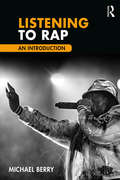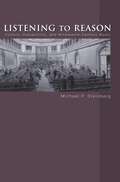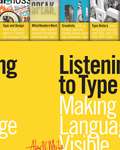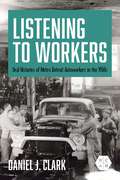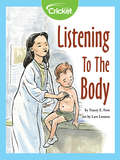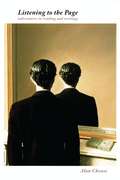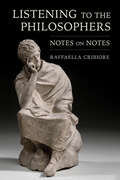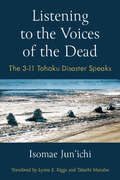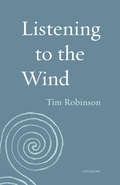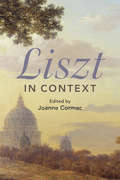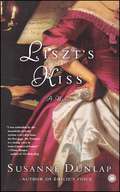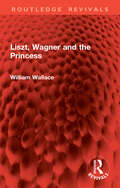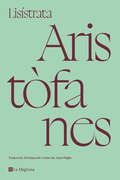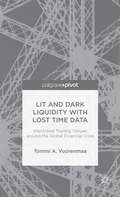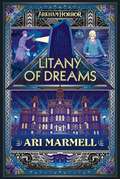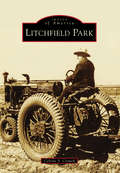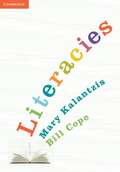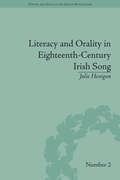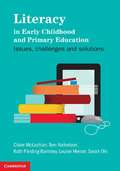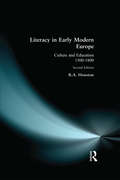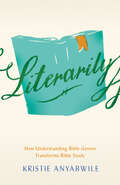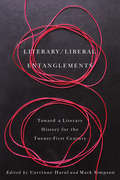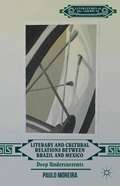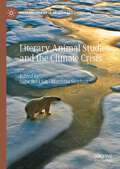- Table View
- List View
Listening to Rap: An Introduction
by Michael Berry<p>Over the past four decades, rap and hip hop culture have taken a central place in popular music both in the United States and around the world. Listening to Rap: An Introduction enables students to understand the historical context, cultural impact, and unique musical characteristics of this essential genre. Each chapter explores a key topic in the study of rap music from the 1970s to today, covering themes such as race, gender, commercialization, politics, and authenticity. Synthesizing the approaches of scholars from a variety of disciplines—including music, cultural studies, African-American studies, gender studies, literary criticism, and philosophy—Listening to Rap tracks the evolution of rap and hip hop while illustrating its vast cultural significance. <p>The text features more than 60 detailed listening guides that analyze the musical elements of songs by a wide array of artists, from Afrika Bambaataa and Grandmaster Flash to Nicki Minaj, Jay-Z, Kanye West, and more. A companion website showcases playlists of the music discussed in each chapter. Rooted in the understanding that cultural context, music, and lyrics combine to shape rap’s meaning, the text assumes no prior knowledge. For students of all backgrounds, Listening to Rap offers a clear and accessible introduction to this vital and influential music.</p>
Listening to Reason: Culture, Subjectivity, and Nineteenth-Century Music
by Michael P. SteinbergThis pathbreaking work reveals the pivotal role of music--musical works and musical culture--in debates about society, self, and culture that forged European modernity through the "long nineteenth century." Michael Steinberg argues that, from the late 1700s to the early 1900s, music not only reflected but also embodied modern subjectivity as it increasingly engaged and criticized old regimes of power, belief, and representation. His purview ranges from Mozart to Mahler, and from the sacred to the secular, including opera as well as symphonic and solo instrumental music. Defining subjectivity as the experience rather than the position of the "I," Steinberg argues that music's embodiment of subjectivity involved its apparent capacity to "listen" to itself, its past, its desires. Nineteenth-century music, in particular music from a north German Protestant sphere, inspired introspection in a way that the music and art of previous periods, notably the Catholic baroque with its emphasis on the visual, did not. The book analyzes musical subjectivity initially from Mozart through Mendelssohn, then seeks it, in its central chapter, in those aspects of Wagner that contradict his own ideological imperialism, before finally uncovering its survival in the post-Wagnerian recovery from musical and other ideologies. Engagingly written yet theoretically sophisticated, Listening to Reason represents a startlingly original corrective to cultural history's long-standing inhibition to engage with music while presenting a powerful alternative vision of the modern.Some images inside the book are unavailable due to digital copyright restrictions.
Listening to Type: Making Language Visible
by Alex W. WhiteWith this visually stunning primer, designers will develop the skills and vision to produce truly innovative, eye-catching type design. All the basics of type design are covered, and in-depth information is provided on more advanced topics such as the differences between type applications, how typography creates identity, and what best inspires readers. Chapters cover:The language of typeSpace and typeTypographic unityWhat makes readers respondType and identityEvolving type treatmentsReadability and legibilityA timeline of the evolution of writing and typographyDesigner Alex W. White packs the pages with fifteen hundred images-modern and ancient, specially created and found-that illustrate typographic concepts and continue to yield more complexity and connectivity with each viewing. Listening to Type proves that type is much more than groups of letterforms on a page; it is a language with the ability to convey meaning and evoke emotions beyond the spoken words it symbolizes.Allworth Press, an imprint of Skyhorse Publishing, publishes a broad range of books on the visual and performing arts, with emphasis on the business of art. Our titles cover subjects such as graphic design, theater, branding, fine art, photography, interior design, writing, acting, film, how to start careers, business and legal forms, business practices, and more. While we don't aspire to publish a New York Times bestseller or a national bestseller, we are deeply committed to quality books that help creative professionals succeed and thrive. We often publish in areas overlooked by other publishers and welcome the author whose expertise can help our audience of readers.
Listening to Workers: Oral Histories of Metro Detroit Autoworkers in the 1950s (Working Class in American History)
by Daniel J. ClarkHistorians and readers alike often overlook the everyday experiences of workers. Drawing on years of interviews and archival research, Daniel J. Clark presents the rich, interesting, and sometimes confounding lives of men and women who worked in Detroit-area automotive plants in the 1950s. In their own words, the interviewees frankly discuss personal matters like divorce and poverty alongside recollections of childhood and first jobs, marriage and working women, church and hobbies, and support systems and workplace dangers. Their frequent struggles with unstable jobs and economic insecurity upend notions of the 1950s as a golden age of prosperity while stories of domestic violence and infidelity open a door to intimate aspects of their lives. Taken together, the narratives offer seldom-seen accounts of autoworkers as complex and multidimensional human beings. Compelling and surprising, Listening to Workers foregoes the union-focused strain of labor history to provide ground-level snapshots of a blue-collar world.
Listening to the Body
by Tracey E. FernDoctors have been listening to the sounds of the human body for more than two thousand years, but did not begin associating those noises with health until the mid-1700s. Doctor Rene Laennec remembered the importance of listening when treating his patients, leading him to invent the stethoscope, which doctors still use today.
Listening to the Page: Adventures in Reading and Writing
by Alan CheuseWhen he sold his first short story to The New Yorker in 1979, Alan Cheuse was hardly new to the literary world. He had studied at Rutgers under John Ciardi, worked at the Breadloaf Writing Workshops with Robert Frost and Ralph Ellison, written hundreds of reviews for Kirkus Reviews, and taught alongside John Gardner and Bernard Malamud at Bennington College for nearly a decade. Soon after the New Yorker story appeared, Cheuse wrote a freelance magazine piece about a new, publicly funded broadcast network called National Public Radio, and a relationship of reviewer and radio was born. In Listening to the Page, Alan Cheuse takes a look back at some of the thousands of books he has read, reviewed, and loved, offering retrospective pieces on modern American literary figures such as Hemingway, Thomas Wolfe, Bernard Malamud, and John Steinbeck, as well as contemporary writers like Elizabeth Tallent and Vassily Aksyonov. Other essays explore landscape in All the Pretty Horses, the career of James Agee, Mario Vargas Llosa and naturalism, and the life and work of Robert Penn Warren.
Listening to the Philosophers: Notes on Notes
by Raffaella CribioreListening to the Philosophers offers the first comprehensive look into how philosophy was taught in antiquity through a stimulating study of lectures by ancient philosophers that were recorded by their students. Raffaella Cribiore shows how the study of notes—whether Philodemus of Gadara's notes of Zeno's lectures in the first century BCE, or Arrian recording the Discourses of Epictetus in the second century CE, or the students of Didymus the Blind in the fourth century and Olympiodorus in the sixth century—can enable us to understand the methods and practices of what was an orally conducted education. By considering the pedagogical and mnemonic role of notetaking in ancient education, Listening to the Philosophers demonstrates how in antiquity the written and the spoken worlds were intimately intertwined.
Listening to the Voices of the Dead: The 3-11 Tohoku Disaster Speaks (Michigan Monograph Series in Japanese Studies #103)
by Jun'ichi IsomaeListening to the Voices of the Dead is an account of the author’s search for the disquieted voices of the dead in the wake of the March 11, 2011, Tōhoku Disaster and his attempt to translate those voices for the living. Isomae Jun’ichi considers the disaster a challenge for outside observers to overcome, especially for practitioners of religion and religious studies. He chronicles the care and devotion for the dead shown by ordinary people, people displaced from their homes and loved ones. Drawing upon religious studies, Japanese history, postcolonial studies, and his own experiences during the disaster, Isomae uncovers historical symptoms brought to the surface by the traumas of disaster. Only by listening to the disquieted voices of the dead, translating them, and responding to them can we regain our true selves as well as offer peace to the spirits of the victims. While Listening to the Voices of the Dead focuses on a specific event in Japanese history and memory, it captures a broadening critique at the heart of many movements responding to how increasing globalization impacts our sense of place and community.
Listening to the Wind
by Tim RobinsonA mapmaker’s vivid journey through the geography, ecology, and history of Ireland’s Connemara region.Here is Connemara, experienced at a walker’s pace. From cartographer Tim Robinson comes the second title in the Seedbank series, a breathtakingly intimate exploration of one beloved place’s geography, ecology, and history.We begin with the earth right in front of his boots, as Robinson unveils swaths of fiontarnach—fall leaf decay. We peer from the edge of the cliff where Robinson’s house stands on rickety stilts. We closely examine an overgrown patch of heather, a flush of sphagnum moss. And so, footstep by footstep, moment by moment, Robinson takes readers deep into this storied Irish landscape, from the “quibbling, contentious terrain” of Bogland to the shorelines of Inis Ní to the towering peaks of Twelve Pins.Just as wild and essential as the countryside itself are its colorful characters, friends and legends and neighbors alike: a skeletal, story-filled sheep farmer; an engineer who builds bridges, both physical and metaphorical; a playboy prince and cricket champion; and an enterprising botanist who meets an unexpected demise. Within a landscape lie all other things, and Robinson rejoices in the universal magic of becoming one with such a place, joining with “the sound of the past, the language we breathe, and our frontage onto the natural world.” Situated at the intersection of mapmaking and mythmaking, Listening to the Wind is at once learned and intimate, elegiac and magnificent—an exceptionally rich “book about one place which is also about the whole world” (Robert Macfarlane).“Visitors to Connemara, that expanse of stony beauty in the west of Ireland, are often struck by its stillness. [This] collection of essays succeeds in the difficult task of staying true to the verities of a place on to which so many fantasies have been projected.” —The Guardian
Liszt in Context (Composers in Context)
by Joanne CormacLiszt in Context explores the political, social, philosophical and professional currents that surrounded Franz Liszt and illuminates the competing forces that influenced his music. Liszt was immersed in the religious, political and cultural debates of his day, and moved between institutions, places, and social circles with ease. All of this makes for a rich contextual tapestry against which Liszt composed some of the most iconic, popular, and also contentious music of the nineteenth century. His significance and astonishing reach cannot be over-stated, and his presence in nineteenth-century European culture, and his continuing influence into the twentieth and twenty-first centuries, are overwhelming. The focus on context, reception, and legacy that this volume provides reveals the multifaceted nature of Liszt's impact during his lifetime and beyond.
Liszt's Kiss
by Susanne DunlapThe romantic story of a young female pianist in cholera-ravaged Paris of 1832, whose own tragedy leaves her susceptible to the passions and scandals of the composer Franz Liszt At the height of the Romantic era in Paris, there was no bigger celebrity than the composer and pianist Franz Liszt. A fiery and gorgeous Hungarian, he made women swoon at soirees and left a trail of broken hearts behind him. Anne, a countess and talented young pianist whose mother has just died of cholera, hears Franz Liszt in concert and is swept up in his allure. The enigmatic Marie d'Agoult, a friend of Anne's late mother, takes her under her wing and introduces her to the artistic world -- despite the objections of Anne's sullen and sorrowful father. Anne soon finds herself in the midst of dangerous intrigues, discovering a family secret so shocking that her father will go to any lengths to protect it. With the ominous presence of Paris's most deadly epidemic looming over every turbulent event, Liszt's Kiss is a rich evocation of a remarkable period as seen through the eyes of a sensitive young artist.
Liszt, Wagner and the Princess (Routledge Revivals)
by William WallaceOriginally published in 1927, this illuminating study concerns three people, about two of whom much has already been written. The third, Princess Carolyne Sayn-Wittgenstein, has attracted less attention, in spite of her having occupied the greater part of Liszt’s inner life. The Princess in the large sense was an unmusical woman. It is a question whether her influence over Liszt was of a beneficient nature. She interested herself in Berlioz only for the purpose of checkmating Wagner, whom she hated, and thus set Liszt against Wagner whenever possible. The complex relationships of this inscrutable and not altogether scrupulous trio are here considered for the first time in a way which adds much of value to our estimate of the characters of Wagner and Liszt.
Lisístrata
by AristòfanesLisístrata es va estrenar l’any 411 a.C., en un moment crític per Atenes, cada cop més asfixiada per la guerra contra Esparta. Durant la llarga guerra del Peloponès, atenesos i espartans deixen de banda les seves llars i els seus deures familiars. Per posar fi a la situació, la bella Lisístrata cridarà les dones dels dos bàndols a una revolta sense precedents: una vaga de sexe que forci la reflexió dels soferts combatents. El doble missatge pacifista i feminista de Lisístrata -i el seu caràcter eventualment vodevilesc- ha fet que sigui l’obra d’Aristòfanes més representada, imitada i adaptada des de mitjan segle XIX ençà, no solament en el teatre de text, sinó també en el teatre musical, en l’òpera, en el cinema i en el còmic, arribant fins i tot a esdevenir una eina simbòlica de denúncia de conflictes armats contemporanis.
Lit and Dark Liquidity with Lost Time Data: Interlinked Trading Venues around the Global Financial Crisis
by Tommi A. VuorenmaaIn Measuring Liquidity and Lost Time Data, Vuorenmaa analyses liquidity to better understand the crux of the financial crisis.
Litany of Dreams: An Arkham Horror Novel (Arkham Horror)
by Ari MarmellDark incantations expose the minds of Miskatonic University students to supernatural horrors, in this chilling mystery novel of Arkham HorrorThe mysterious disappearance of a gifted student at Miskatonic University spurs his troubled roommate, Elliot Raslo, into an investigation of his own. But Elliot already struggles against the maddening allure of a ceaseless chant that only he can hear… When Elliot&’s search converges with that of a Greenland Inuk&’s hunt for a stolen relic, they are left with yet more questions. Could there be a connection between Elliot&’s litany and the broken stone stele covered in antediluvian writings that had obsessed his friend? Learning the answers will draw them into the heart of a devilish plot to rebirth an ancient horror.
Litchfield Park
by Celeste S. CrouchIn 1908, William Kriegbaum, a California citrus grower, arrived as the first settler in what was to become Litchfield Park. He, along with other settlers from California, owned the land until 1916, when Paul Litchfield of Goodyear Tire & Rubber Company came to the area and purchased 16,000 acres to plant cotton for tires. In 1918, the townsite was planned with tree-lined streets and buildings to include an "organizational house" for Goodyear executives, which is now the famed Wigwam Resort. When new materials for tires were developed, cotton was no longer needed for cord. Shortly thereafter, Goodyear brought its tire-testing fleet to Litchfield, and farm equipment companies followed suit, sending engineers to design and test new machinery. The steel-wheeled tractor tire was replaced by Paul Litchfield's newly patented pneumatic tire as the standard for farm equipment. The World War II years brought changes to the area as an influx of new residents transformed the company town to a more planned community.
Literacies
by Bill Cope Mary KalantzisWith the rise of new technologies and media, the way we communicate is rapidly changing. Literacies provides a comprehensive introduction to literacy pedagogy within today's new media environment. It focuses not only on reading and writing, but also on other modes of communication, including oral, visual, audio, gestural and spatial. This focus is designed to supplement, not replace, the enduringly important role of alphabetical literacy. Using real-world examples and illustrations, Literacies features the experiences of both teachers and students. It maps a range of methods that teachers can use to help their students develop their capacities to read, write and communicate. It also explores the wide range of literacies and the diversity of socio-cultural settings in today's workplace, public and community settings. With an emphasis on the 'how-to' practicalities of designing literacy learning experiences and assessing learner outcomes, this book is a contemporary and in-depth resource for literacy students.
Literacy and Orality in Eighteenth-Century Irish Song (Poetry and Song in the Age of Revolution #2)
by Julie HeniganFocusing on several distinct genres of eighteenth-century Irish song, Henigan demonstrates in each case that the interaction between the elite and vernacular, the written and oral, is pervasive and characteristic of the Irish song tradition to the present day.
Literacy in Early Childhood and Primary Education
by Claire Mclachlan Louise Mercer Ruth Fielding-Barnsley Tom Nicholson Sarah OhiLiteracy in Early Childhood and Primary Education provides a comprehensive introduction to literacy teaching and learning. The book explores the continuum of literacy learning and children's transitions from early childhood settings to junior primary classrooms and then to senior primary and beyond. Reader-friendly and accessible, this book equips pre-service teachers with the theoretical underpinnings and practical strategies to teach literacy. It places the 'reading wars' firmly in the past as it examines contemporary research and practices. The book covers important topics such as assessment, multiliteracies, reading difficulties and diverse classrooms. Each chapter includes learning objectives, reflective questions and definitions of key terms to engage and assist readers. Written by an expert author team and featuring real-world examples from literacy teachers and learners, the book will help pre-service teachers feel confident teaching literacy to diverse age groups and abilities.
Literacy in Early Modern Europe
by R. A. HoustonThe new edition of this important, wide-ranging and extremely useful textbook has been extensively re-written and expanded. Rab Houston explores the importance of education, literacy and popular culture in Europe during the period of transition from mass illiteracy to mass literacy. He draws his examples for all over the continent; and concentrates on the experience of ordinary men and women, rather than just privileged and exceptional elites.
Literarily: How Understanding Bible Genres Transforms Bible Study
by Kristie AnyabwileDon&’t just read the Bible literally—read it Literarily.A lot of times, we treat Scripture like it&’s all the same from Genesis to Revelation. After all, it only has one Author. Isn&’t it just one big book, identical from beginning to end?While it&’s true that the Bible is unified, it is also diverse. The Bible can be grouped according to key categories, called genres, that help us to read and properly interpret the Scriptures. An understanding of these genres, and the literary themes and devices used within them, makes all the difference when encountering God&’s Word.Long-time Bible teacher Kristie Anyabwile discovered as she prepared her lessons that a single inductive approach doesn&’t do justice to the variety of genres that make up the Word of God. Because Scripture is a collection of writings that spans 1,500 years, many literary styles are represented and each must be taken into account for the fullest understanding of God&’s Word. Kristie shows you the immense value of studying the Bible literarily—that is, according to the literary style presented in a particular book, chapter, or passage. In Literarily, Kristie will take you through these eight distinct genres:LawHistoryProphecyPoetryGospelsEpistlesWisdomApocalypticThe Bible is an epic story that God has revealed to us through diverse genres and literary features. Its message and method are both meant to transform our hearts. Our goal as interpreters isn&’t to meld the Scriptures into a bland conglomerate, but to recognize the multiple forms in which God&’s Word comes to us. In so doing, we&’ll encounter the ongoing story of Jesus&’s redemption and learn how He calls His people to live in our complex world today.
Literarily: How Understanding Bible Genres Transforms Bible Study
by Kristie AnyabwileDon&’t just read the Bible literally—read it Literarily.A lot of times, we treat Scripture like it&’s all the same from Genesis to Revelation. After all, it only has one Author. Isn&’t it just one big book, identical from beginning to end?While it&’s true that the Bible is unified, it is also diverse. The Bible can be grouped according to key categories, called genres, that help us to read and properly interpret the Scriptures. An understanding of these genres, and the literary themes and devices used within them, makes all the difference when encountering God&’s Word.Long-time Bible teacher Kristie Anyabwile discovered as she prepared her lessons that a single inductive approach doesn&’t do justice to the variety of genres that make up the Word of God. Because Scripture is a collection of writings that spans 1,500 years, many literary styles are represented and each must be taken into account for the fullest understanding of God&’s Word. Kristie shows you the immense value of studying the Bible literarily—that is, according to the literary style presented in a particular book, chapter, or passage. In Literarily, Kristie will take you through these eight distinct genres:LawHistoryProphecyPoetryGospelsEpistlesWisdomApocalypticThe Bible is an epic story that God has revealed to us through diverse genres and literary features. Its message and method are both meant to transform our hearts. Our goal as interpreters isn&’t to meld the Scriptures into a bland conglomerate, but to recognize the multiple forms in which God&’s Word comes to us. In so doing, we&’ll encounter the ongoing story of Jesus&’s redemption and learn how He calls His people to live in our complex world today.
Literary / Liberal Entanglements: Toward a Literary History for the Twenty-First Century
by Corrinne Harol Mark SimpsonIn Literary/Liberal Entanglements, Corrinne Harol and Mark Simpson bring together ten essays by scholars from a wide range of fields in English studies in order to interrogate the complex, entangled relationship between the history of literature and the history of liberalism. The volume has three goals: to investigate important episodes in the entanglement of literary history and liberalism; to analyze the impact of this entanglement on the secular and democratic projects of modernity; and thereby to reassess the dynamics of our neoliberal present. The volume is organized into a series of paired essays, with each pair investigating a concept central to both literature and liberalism: acting, socializing, discriminating, recounting, and culturing. Collectively, the essays demonstrate the vivid capacity of literary study writ large to reckon with, imagine, and materialize durative accounts of history and politics. Literary/Liberal Entanglements models a method of literary history for the twenty-first century.
Literary And Cultural Relations Between Brazil And Mexico
by Paulo MoreiraJoining a timely conversation within the field of intra-American literature, this study takes a fresh look at Latin America by locating fragments and making evident the mostly untold story of horizontal (south-south) contacts across a multilingual, multicultural continent.
Literary Animal Studies and the Climate Crisis (Palgrave Studies in Animals and Literature)
by Matthias Stephan Sune BorkfeltLiterary Animal Studies and the Climate Crisis connects insights from the field of literary animal studies with the urgent issues of climate change and environmental degradation, and features considerations of new interventions by literature in relation to these pressing questions and debates. This volume informs academic debates in terms of how nonhuman animals figure in our cultural imagination of topics such as climate change, extinction, animal otherness, the posthuman, and environmental crises. Using a diverse set of methodologies, each chapter presents relevant cases which discuss the various aspects of these interstices. This volume is an intersection between literary animal studies and climate fiction intended as an interdisciplinary intervention that speaks to the global climate debate and is thus relevant across the environmental humanities.
